Trees Birds Mammals Fish Amphibians Reptiles
Wild Algarve
Bookshop
Bulgaria inquinans (Pers.) Fr. - Black Bulgar
Class: Leotiomycetes - Order: Helotiales - Family: Bulgariaceae - Phylum: Ascomycota
Distribution - Taxonomic History - Etymology - Identification - Toxicity - Reference Sources
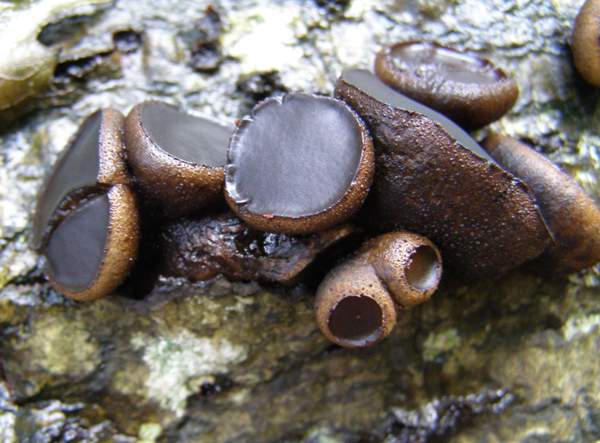
Bulgaria inquinans, sometimes referred to as the
Black Bulgar, Bachelor's Buttons or Rubber Buttons, grows in groups most commonly on felled oak trunks and fallen branches, and occasionally on other dead hardwoods including Ash.
Despite its texture this is not one of the hererobasidiomycetes 'Jelly Fungi' which belong to the class Basidiomycota. Bulgaria inquinans belongs to the Ascomycota.
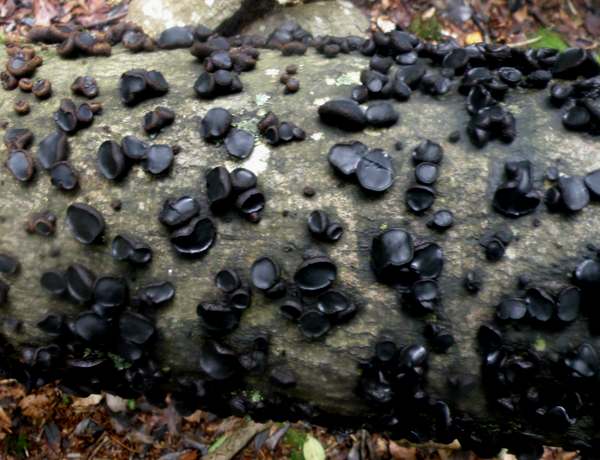
Because of the current Ash Dieback disease, many more trees are falling or having to be felled for safety reasons, and so Bulgaria inquinans is probably in for a feast; we can expect to see these already fairly common little button-like fungi even more frequently in years to come.
They may look like liquorice or black gumdrops (and indeed in the USA they are sometimes referred to a Black Jelly Drops or Poor Man's Licorice), but Black Bulgars are not considered to be edible fungi and they may possibly contain toxins.
Distribution
A fairly common and widespread woodland species in Britain and Ireland, Bulgaria inquinans is found also throughout mainland Europe and in many other regions of the world including parts of North America, where it is commonly referred to as Black Jelly Drops.
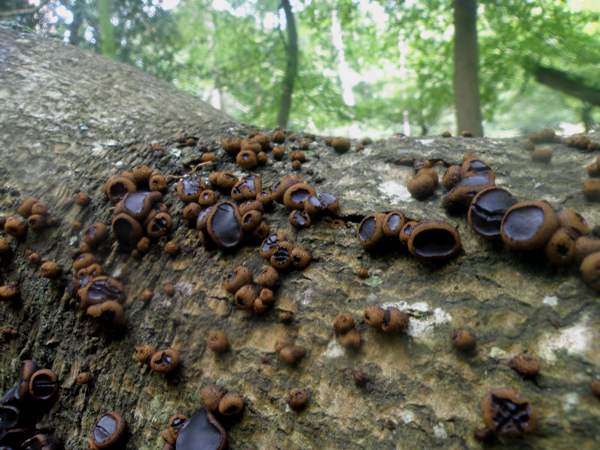
Toxicity
Generally considered as inedible in western countries, and according to some researchers even reported to be poisonous and to cause food-sensitised solar dermatitis, in northeastern China Bulgaria inquinans is treated as a delicacy. We strongly advise against easting these liquorice gum drop lookalikes.
Taxonomic history
The basionym of this species was proposed by Christiaan Hendrik Persoon and subsequently ratified by the great Swedish mycologist Elias Magnus Fries in his 1822 publication Systema Mycologicum.
Synonyms of Bulgaria inquinans include Bulgaria polymorpha (Oeder) Wettst., Tremella turbinata Huds., Peziza turbinata (Huds.) Relhan, Peziza polymorpha Oeder, Peziza inquinans Pers., and Phaeobulgaria inquinans (Pers.) Nannf.
Bulgaria inquinans is the type species of its genus and the only Bulgaria species known to occur in Britain.
Etymology
Bulgaria, the genus name, may be a reference to leathery skin - a leather pounch within which wine was carried. Any other suggestions would be most welcome! Rather more straightforward, the specific epithet inquinans means polluting or staining - a reference to the dark brown stain that comes from handling Black Bulgar fruitbodies.
Identification guide
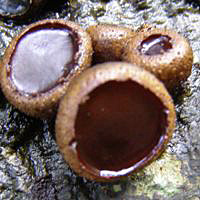 |
Fruitbody
Flat-topped at first but becoming slightly cup
shaped, Bulgaria inquinans is easily overlooked because it is
almost black. Its fertile surface is shiny, and the sides (the outsides of
the cup) are felty and dark brown.
The flesh of the fruitbody is dark ochre-brown. It is soft and rubbery
in wet weather but in dry conditions it becomes tougher and more like
elastic.
Often growing in dense masses, the individual fruit bodies are between
0.5 and 4cm across and typically 1cm tall. |
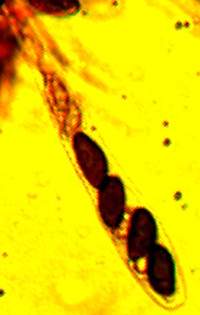 |
Asci
Typically 200 x 9µm, with eight spores per ascus. |
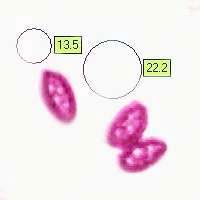 |
Spores
The top four spores in each ascus are dark brown, ellipsoidal to kidney shaped, smooth, 11-14 x 6-7µm. The lower four spores are hyaline (colourless), kidney shaped and much smaller at 5-7 x 2-4µm.
Spore print
Very dark brown, almost black. |
Odour/taste |
Not distinctive. |
Habitat & Ecological role |
Saprobic, on felled oaks, Sweet Chestnut and Beech; less frequently on Ash. |
Season |
September to March in Britain and Ireland. |
Similar species |
Neobulgaria pura is similar in shape and size but creamy
white.
Witches' Butter Exidia glandulosa is much softer black fungus and belongs to the Jelly Fungus group. |
Reference Sources
Fascinated by Fungi, 2nd Edition, Pat O'Reilly 2016, reprinted by Coch-y-bonddu Books in 2022.
Mao, X.L (1980). Toxic mushrooms and poisoning. Journal of Preventative Medical Science of China 14: 188-192 [NB: this paper is published in Chinese].
Dennis, R.W.G. (1981). British Ascomycetes; Lubrecht & Cramer; ISBN: 3768205525.
Dictionary of the Fungi; Paul M. Kirk, Paul F. Cannon, David W. Minter and J. A. Stalpers; CABI, 2008
Taxonomic history and synonym information on these pages is drawn from many sources but in particular from the British Mycological Society's GB Checklist of Fungi.
Top of page...
Fascinated by Fungi. Back by popular demand, Pat O'Reilly's best-selling 450-page hardback book is available now. The latest second edition was republished with a sparkling new cover design in September 2022 by Coch-y-Bonddu Books. Full details and copies are available from the publisher's online bookshop...